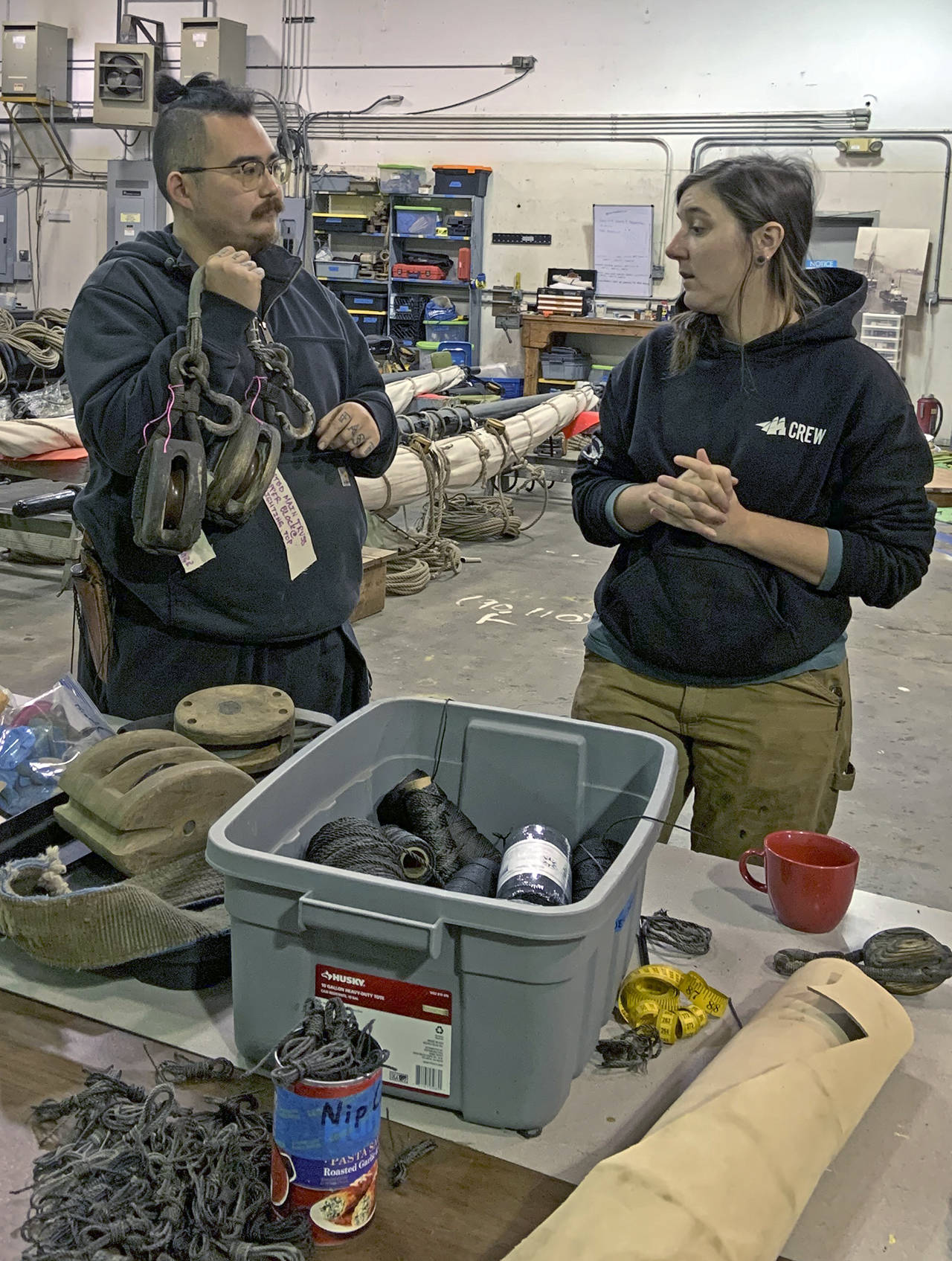By Kat Bryant
The Daily World
In the wake of a stormy financial year, the tall ship Lady Washington is now at risk of permanent shutdown.
Aberdeen’s grande dame traditionally sails up and down the Pacific Coast for 11 months of every year, hosting educational tours in various ports and taking passengers on short outings. But with COVID-19 restrictions curtailing such activities in 2020, very little income has been generated — leaving the nonprofit Grays Harbor Historical Seaport relying almost solely on public funding and donations.
“It’s been a brutal year. Our earned revenue is down $470,000 due to shutting down for COVID,” said Brandi Bednarik, executive director of the seaport. “Lady Washington was only able to work July and August of this year, with just 10 guests at a time.”
Last year’s decision to sell the port’s other resident tall ship, Hawaiian Chieftain, has yet to bear fruit: The seaport is asking $150,000 for that ship, which currently is being shown at Pier 39 in Astoria, Oregon.
Despite some COVID-related funding and other income, the operations shortfall for Lady Washington will be about $78,000 for the next few months, she said. So, that’s the total amount she is requesting from donors through a year-end fundraising campaign.
“Part of the reason for the big ask is that it represents everything we need through April,” said Bednarik. “If we don’t get it, we may not be able to bring a full crew back in February to uprig” — which would mean Lady Washington couldn’t sail again in the spring.
Tall-ship crew members are a limited commodity, Captain Halee Grimes noted. If hiring plans aren’t made well in advance, the region’s talent pool shrinks significantly. Therefore, the money needs to be secured for at least a couple of months’ payroll by early January to avoid delays.
Maintaining course
The silver lining to this prolonged downtime is that the crew can perform some much-needed maintenance. The Lady has been downrigged and cocooned at the port, and a skeleton crew — most of whom are unpaid volunteers — is performing deep maintenance on the ship’s components inside one of the seaport’s buildings.
Downrigging involves taking down the sails, spars, rigging and other components; labeling each item to ensure it eventually gets back to its correct place; and preparing every piece, one by one, for a new season.
It’s a vastly time- and energy-consuming task for any crew, but a necessary undertaking. Grimes noted that it’s especially important with regard to this 31-year-old ship because its body and components are made primarily of Douglas fir, a soft wood that tends to be less resistant to rot and shipworm damage than harder woods such as oak and pine.
On Thursday, Grimes and crew members James Hsu, Brooke Gipson, Tanith Anhaiser and Ryan Medley were busily stripping and refurbishing blocks (wooden pulleys) and strops (spliced loops of rope), then tarring the finished pieces and hanging them up to dry.
Tarring the rope makes the rigging more water-resistant — which is crucial because the line tension is what holds the masts upright. “They’re not bolted in,” Anhaiser explained.
Bednarik noted that the captain and crew are living above the large work area for the winter. “We’ve got two bunk rooms and a crew lounge up there,” she said. “We’re a quarantine family.”
Grimes said it’s an efficient and agreeable arrangement for all of them.
“There’s a support network built into working on boats like this, and it’s a lot stronger than a family support network because you have to rely on these people to take care of you (if there’s an emergency),” she said. “It instills a lot of trust and confidence in each other. It builds good teamwork skills and strong ties. You’re pretty much friends forever afterward.”
Generating funds
Year-end donations already have started flowing in, Bednarik said.
“Our donors have been very loyal,” she said. “Without them, we would already be shut down.”
Still, she’s optimistic that the lofty fundraising goal will be met. The Aberdeen lodging tax committee is recommending a $10,000 allocation from the city council, she said, and the county has committed $15,000. The seaport recently received $10,000 in arts funding, and several other grants are in the works, she added.
In addition, the group recently conducted an online auction that brought in about $2,700, selling seaport merchandise, some bits of memorabilia from the site, and a few things handmade by the crew.
They’re hoping to run another auction in the spring. “We’re making a pile of stuff for it,” said Grimes.
For now, Bednarik, Grimes and the crew are doing their best to anticipate and keep up with their expenses. That primarily means spending only the money they have in hand.
“We’re not doing anything on credit,” said Bednarik. “We’re living on debit cards and hope.”
Future revenue-generating plans include making the current work area into an event center — a project that’s been on their list for some time now. Bednarik hopes to make it happen in 2021 with some paint, sound panels, and construction of a permanent stage and bar.
“We won’t have tables or chairs or anything — it’ll be sort of raw,” she said. “But we’re already getting some interest in it.”
On the community side, she’s also looking forward to working with the local Sea Scouts in the coming year, offering them training and experience as they work toward their goals. It’s one of many public outreach efforts the seaport tries to engage in every year.
“The Lady is something we don’t want to lose,” said Bednarik. “It’s a historical treasure. It’s an experience you can’t just go out and get anywhere else.”
Anyone interested in making a donation may visit the seaport’s website at HistoricalSeaport.org and click on the “Donate” button up top of the home page.


